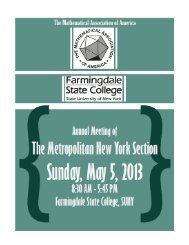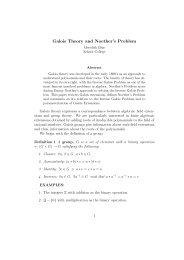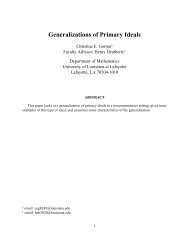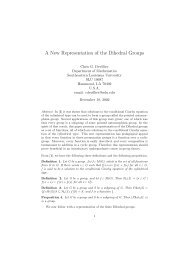Solving Recurrence Relations Using Differential Operators - Sections
Solving Recurrence Relations Using Differential Operators - Sections
Solving Recurrence Relations Using Differential Operators - Sections
You also want an ePaper? Increase the reach of your titles
YUMPU automatically turns print PDFs into web optimized ePapers that Google loves.
We begin by multipling the relation by xn<br />
n! and then sum it up from n = 0 to<br />
n = 1. Thus,<br />
1X<br />
n=0<br />
an+1x n<br />
n!<br />
=<br />
1X (n + 1)anxn : (28)<br />
n!<br />
n=0<br />
We distribute the right hand side of the equation to get<br />
1X<br />
n=0<br />
an+1x n<br />
n!<br />
=<br />
1X<br />
n=0<br />
nanx n<br />
n! +<br />
1X anxn : (29)<br />
n!<br />
By resetting our indices we can use equations (9), (10), and (11) to get<br />
This is a separable di¤erential equation:<br />
Integrating, we obtain<br />
<strong>Solving</strong> for h(x) we get<br />
n=0<br />
h 0 (x) = xh 0 (x) + h(x): (30)<br />
h 0 (x)<br />
h(x)<br />
<strong>Using</strong> the initial condition of h(0) = 1, we …nd<br />
1<br />
= : (31)<br />
1 x<br />
ln jh(x)j = ln j1 xj + C: (32)<br />
h(x) = eC<br />
: (33)<br />
1 x<br />
h(x) = 1<br />
: (34)<br />
1 x<br />
We now use the McLaurin series expansion of the right hand side of<br />
h(x) =<br />
1X<br />
x n : (35)<br />
n=0<br />
We need to get h(x) in the correct form so we mulitply by n!<br />
h(x) =<br />
Now we can solve for our an to get<br />
1X<br />
n=0<br />
n!xn : (36)<br />
n!<br />
an = n!: (37)<br />
6

















